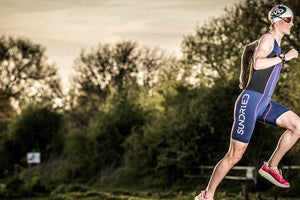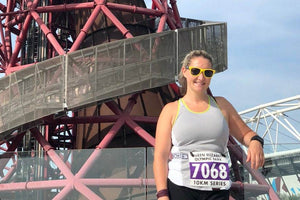You can do all the swim, bike, and run training in the world, but a poor fuelling plan could land you with a dreaded DNF. Read our advice from athletes who have been there, done it, and made the mistakes so you don't have to.
Helena Kvepa – Experienced Ironman Triathlete
I consume 300kcal an hour on the bike and bit less on the run. It's something I do in training as well to get used to it. I eat every 20 minutes on the bike; a mix of gels and bars, and every 5km on the run, gels only. But it's very individual and something to practise on longer workouts.
It's important to hydrate leading up to the race and eat what you are used to. I hear way too many stories of people who stuff themselves with pizza and pasta to carb load and then suffer gastric problems during the race. I just eat as normal, just bigger portions and restrict the fibrous foods.
On race day, I'll have my usual breakfast of porridge with banana and honey and a black coffee. I'll sip 750ml of electrolyte drink while getting ready and have a gel just before the start, but not a caffeinated one as, together with the race nerves, it does terrible things to my blood pressure. I leave a gel and caffeine shot in my bike shoe or helmet to remind myself to take them straight away. I leave bike nutrition in the transition bag so I quickly stuff it in my tri suit.
I carry two bottles of water on my bike. One for the drinks that I replace at every water station and one backup. I always replenish my bottle at each feed station as it's better to have more than you need than to run out before the next station. Also, I carry a few caffeine gels, as in later stages you might need an extra boost. I make my watch beep at me every 20 minutes to remind me to eat. It's better to consume more on the bike than get to the run with an empty tank.
I have another gel and caffeine shot in my running shoe for the run. I have a race belt with a little pocket where I stuff my gels. I take one every 5km and try to time it around the water stations. I sip water and maybe Redbull later in the run. I don't carry water on the run as I make sure I hydrate on the bike so I don't need as much on the run. I can't stomach solids on the run, but other people I know would have a banana or something. If there is a special needs bag, I leave extra emergency gels and caffeine shots in there along with dry socks.
When racing in hot weather, I use salt stick tables. I carry them in the plastic egg found inside Kinder egg. I never skip food; it's better to have more and don't need it, than hit a wall, as it's almost impossible to recover from that. You will never consume as many calories in a long distance triathlon as you will burn.
After the race, I try to eat well and plenty of fruit and vegetables. After a long race, your immune system is depleted, so it's easier to become ill. Get some food in even if you don't feel like it and drink a lot of water.

Vikki Roberts-Caiger – Triathlete & Coach
Start fuelling before you feel you need to! It's almost impossible to recover if you get to the red line in terms of energy. I made the mistake of not taking on enough in T1 on my first middle distance event and so now I'm religious about having an energy bar in T1 and plenty early on during the bike.
Find out what's available on the course and see if it suits you, and if not, be prepared to carry everything you need. I've got a big bento box for the bike on the top bar, two bottles on the frame and use a race vest for the run unless there are lots of aid stations (one every mile at Lakesman for example).
Practise fuelling on your long training sessions. I found that I needed two squares of flapjack/energy balls/quarter sandwich and a Percy Pig every 5 miles on the bike. I also have a swig of electrolytes every 5 miles.
I favour food over gels (although I use them for a boost) and find it's important to have a mix of textures and flavours (I go sweet and savoury). I remember one ride where I only had fig rolls and I physically couldn't swallow them in the last third of the ride!

Steve Vaughan – Team GB Age Group Triathlete
Pre-race, you need to carb-load effectively. There are lots of different techniques and it's not just about eating tons of pasta the day before the race. I use the 6 day method, which means gradually building up carb intake in the week before the race.
On race day, I get up early and eat several hundred calories; I swear by rice pudding. Then I'll drink plenty of water and eat a banana before the start of the swim. After the swim, I try to use the little and often principle. I usually have half an energy bar in my transition bag that I try to eat on my way to mounting the bike (I used to force a gel down as well!) then graze constantly throughout the bike leg.
I break bars up into my box, perhaps put my favourite brand into my pockets if I don’t like the race brand, and then supplement with bananas. I have 2 bottles of carbohydrate drink on the bike to start with and then just take water from the aid stations. If there is an ‘aid bag’ opportunity, I have something savoury and another carbohydrate drink.
I often put something savoury in my T2 bag for the run; I like pretzels, but races now often have a savoury option on the run too. I put 2-3 packets of Clif blocs in my pockets and am disciplined about eating 1 of these with water at each stop (so one about every mile and a bit). If I’m hungry, I eat whatever is on the table!

Ben Greene – World Level Triathlete
It's important to remember that heat, humidity, and race pace all have an impact on digestion. I raced Ironman Cairns in North Australia earlier this year and to prepare over the winter, I completed a number of indoor brick sessions with the thermostat set to 30 degrees Celsius.
I quickly switched from solid fuel (my usual preference) to a more liquid-based approach as I struggled to digest the solid fuel at a higher heart rate (caused by the increase in temperate and race pace).
My top tip: practise your race nutrition in race conditions (i.e. climate and course specific) and at race pace. I've found that fuel which sits well in Zone 1 or 2 during a training ride might not sit so well at Zone 3 on race day.

Marc Went – Experienced Ironman Triathlete
Hydration and nutrition are always a hot topic of conversation and one which we all need to find out what works for us. For me, I found that I can take in gels fine at shorter distances, but for middle distance triathlon upwards, gels became a big gut issue on the run, so of late I've trained and raced with Tailwind. To date, it's been perfect for anything from ultra marathons to full distance Ironman, but I do add some solids on the bike.
The biggest thing I'd say is set out on finding out what works for you months in advance and train/test with it as there is a strong likelihood you'll tweak it along the way. Think how you will manage the volumes needed on the day, albeit using on-course sponsor brands or taking your own and if you'll need to add some additional hydration storage or bento boxes.
With Tailwind, I tend to pre-mix my Xlab Torpedo and carry the rest as a concentrate in a 750ml bottle and mix with water from course aid stations into the Xlab during the race.
Also, think about other factors which may influence your race day nutrition/hydration needs. I'm an above-average sweater, so I found without taking on some additional salts, my legs tended to cramp up later in the race. Since looking at salt loss more closely and introducing salt tablets on the bike and run, this tendency to cramp has gone completely.
Hydrate sufficiently in the week running up to the race and before the swim. Eat and drink little and often; I use my Garmin alarm notification to bleep every few minutes as a reminder.
On the final 10k of the run, take whatever you can and keep smiling!

David Rother – Professional Triathlete
I usually go for a no-carb Monday and Tuesday and start filling up with carbs slowly from Wednesday to Saturday lunchtime. Saturday evening is just a light normal meal. I also reduce my coffee intake during race week to zero to have maximum effect on race morning, when I drink up to 4 double espresso.
On race morning, I'll have some water-overnight oats with a half-ripe banana about 3 hours before the race start. Then I switch to Maurten gels and drink mix and I have one gel before the swim.
On the bike and on the run, I have a set nutrition plan personalised for me and try to execute it as well as I can. Normally, during the run, it's just taking gels and every cup of water, coke or gel that I can grab from the aid stations. Oh, and of course, half a litre of beetroot juice every day during race week!









